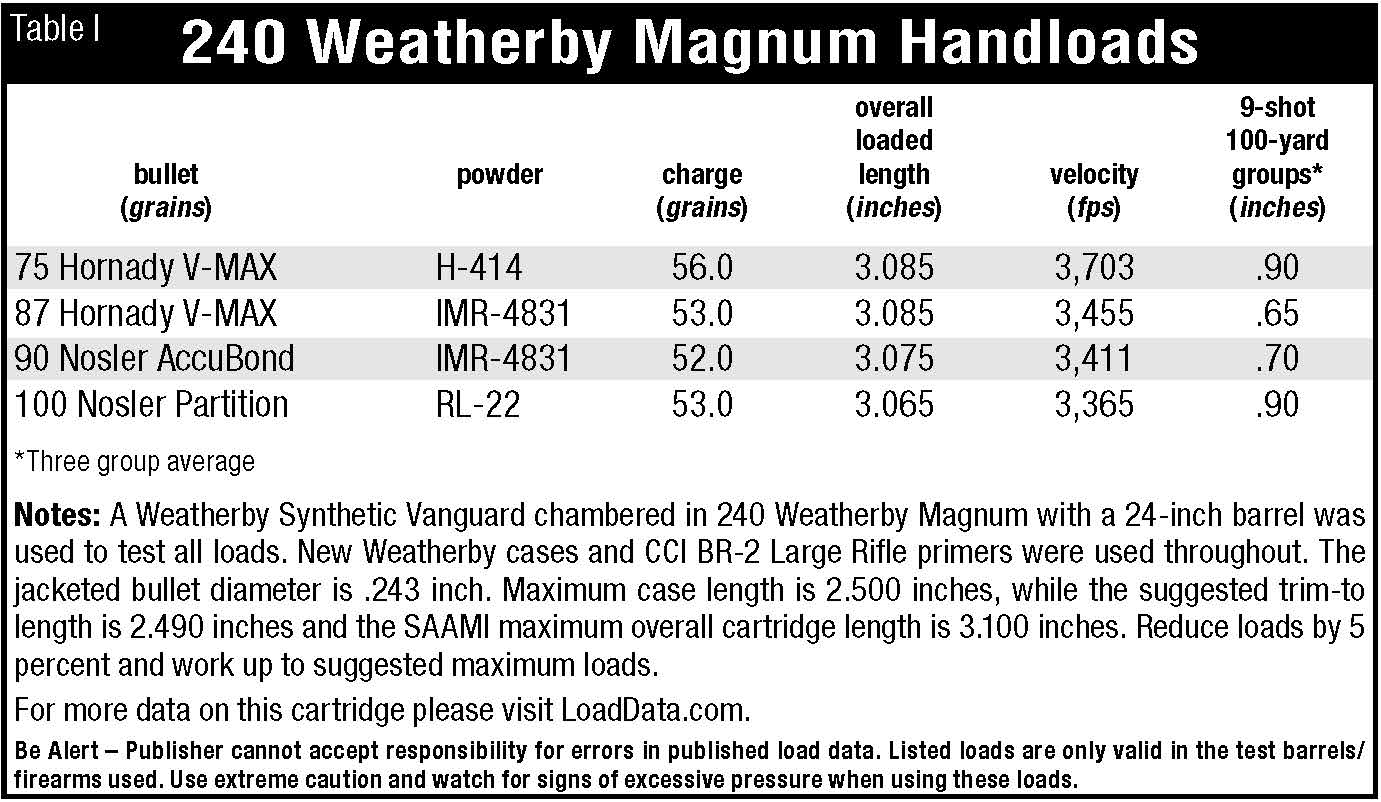The Weatherby Vanguard
Spotlighting a Modern Classic
feature By: Brian Pearce | July, 24


Success was sweet, but by comparison to other domestically manufactured rifles, Weatherby rifles were expensive, as well as factory-loaded, proprietary ammunition. This possibly limited potential sales and Roy recognized the need for a lower-priced rifle that would accept a standardized Sporting Arms and Ammunition Manufacturers’ Institute (SAAMI) cartridge, but was still a quality rifle. In the late 1960s he contracted with Howa Machinery (located in Japan) to manufacture a new bolt-action rifle that would be formally announced in 1970 as the Vanguard and carried a manufacturer’s suggested retail price (MSRP) of less than $200 – a price that was similar to the Winchester Model 70 and Remington 700. Now, more than a half century later, the Vanguard has proven reliable, accurate, versatile and it remains in high demand and is a hugely important part of Weatherby rifles.

During the early 1960s and 1970s, Weatherby Mark V rifles could be readily recognized even from a distance. Even the most basic models featured walnut stocks (often beautifully figured) with pronounced Monte Carlo stock, rosewood forend and pistol grip cap, a white diamond on the bottom of the pistol grip, white-line spacers, cut checkering and high-gloss finish, while the barrel and action had no sights (unless special ordered) and a high-polish blue finish. Roy had created a new fashion in rifle appearance (with several competing manufacturers more or less copying his rifle’s styling) and the Vanguard shared many of the same cosmetics as the Mark V. Sales were strong and the Vanguard was quickly recognized as a great rifle that could readily compete with more traditional U.S. bolt-action hunting rifles.
The new Weatherby Vanguard receiver is round, constructed of a one-piece forging and boasts of an integral recoil lug. The one-piece bolt is likewise forged and has an enclosed bolt sleeve to protect the shooter from gases due to a ruptured case or overloaded cartridge. The right lug is slotted


There are two action lengths, with the short action readily housing 223 Remington through 308 Winchester length cartridges (including the Winchester WSM cartridges that measure up to 2.860 inches), while the long action houses the 30-06 family of cartridges that measure around 3.340 inches, but it is also long enough to house the 300 Weatherby Magnum at 3.600 inches.
With huge trends towards synthetic stocks, the Vanguard was eventually offered with both classic and Monte Carlo-style synthetic stocks, while the blue finish was changed to a flat black matte and stainless steel variants became available. While the

Beginning in 2012, the Vanguard Series 2 that appeared that has been upgraded and improved mechanically when compared to the original. The extractor and ejector have been slightly repositioned for even more reliable function. The trigger is now two-stage and boasts of a clean breaking 2½-pound pull right out of the box. The sliding safety is upgraded to a three-position-style with the middle position allowing the bolt to be opened to remove a loaded cartridge while the safety remains in the ON position. The stocks have been revamped to a more trim profile and feature a live rubber recoil pad. (It should be noted that prior to the introduction of the Series 2, the Vanguard had been steadily improved with additional venting in the bolt body to better protect the shooter in the event of a ruptured case and the bolt body became fluted for even smoother operation.)

Weatherby offers an Accuracy Guarantee that states: “All Weatherby Vanguard Series 2 rifles are guaranteed to shoot a 3-shot group of .99 or less at 100 yards (SUB-MOA) when used with specified Weatherby factory or premium ammunition.” In developing extensive load data for many different cartridges for Wolfe Publishing’s LoadData.com, this shooter has fired an astonishing number of rounds through original and Series 2 Vanguard rifles. They have categorically produced accuracy that meets Weatherby’s Accuracy guarantee and is usually much better!
As indicated, the Vanguard was originally offered in SAAMI-specified standard and magnum calibers only. However, due to consumer demand, it is now produced in many Weatherby calibers (most of which became SAAMI-approved cartridges in 1994). For today’s purposes, a Vanguard Series 2 Synthetic was selected. This appears to be the lowest-priced Vanguard offered with a modest MSRP of just $549, which in today’s regularly inflating prices of all goods, is a genuine bargain! Weatherby refers to the synthetic stock as Griptonite, which is weather resistant and even when wet, offers traction. It is gray with black rubber inserts in the pistol grip and forearm. The test rifle was chambered in 240 Weatherby Magnum and is fitted with a 24-inch barrel.
The 240 Weatherby Magnum is an interesting cartridge. After the huge success of the 243 Winchester beginning in 1955 (that continues to date), Roy decided to add the 240 in 1968, which was originally only offered in the Mark V but is now available in the Vanguard. It has the traditional Weatherby double-radius shoulder; however, the case is not based on any other. It is belted, but the head and rim diameter is .472 inch, while the 30-06 rim diameter is .473 inch. This allows the 240 to be used with the same bolt face and actions as the 30-06 and the belt is largely cosmetic, rather, it headspaces off the shoulder. The 240 has a maximum overall cartridge length of 3.100 inches, so it is built on rifles with a 30-06-length action. As indicated, most Weatherby cartridges were adopted by SAAMI in 1994, and the 240 has a maximum average pressure of 53,500 CUP, or 63,817 psi (CIP).
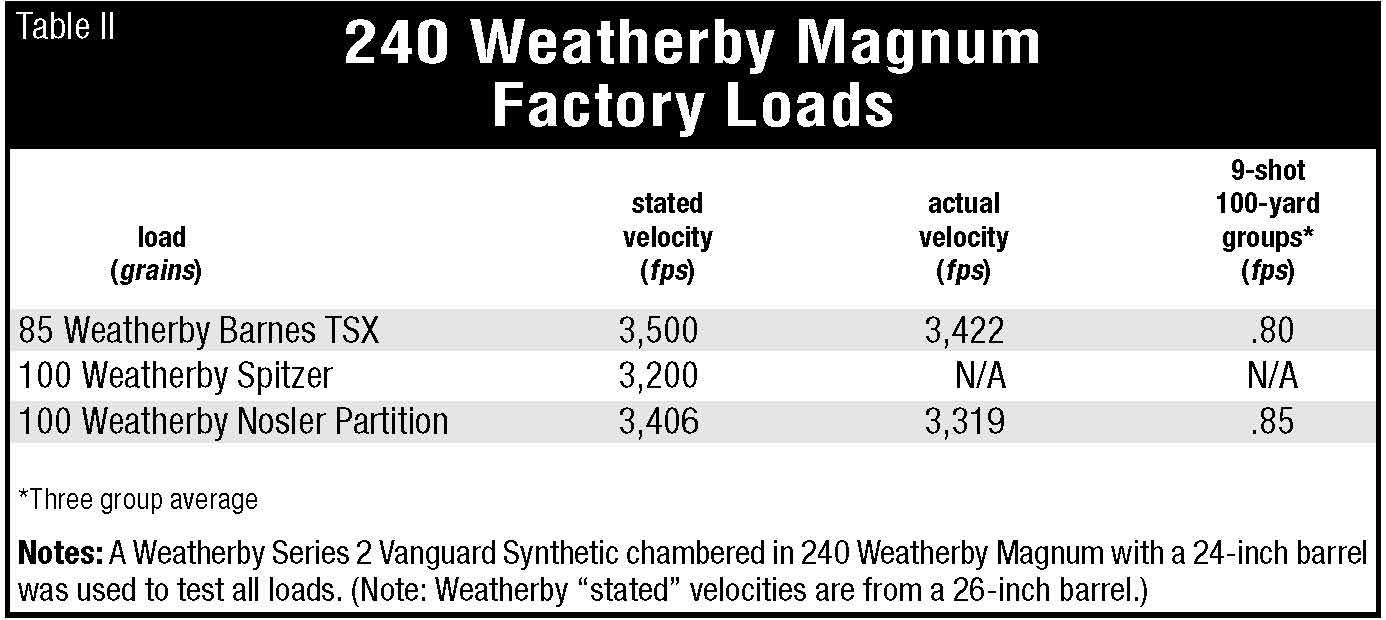
With comparable bullets, the 240 has a notable ballistic advantage over the 243 Winchester, 243 WSSM, 6mm Remington and 6mm Creedmoor. For example, Weatherby factory loads list the Barnes 80-grain TTSX bullet at 3,500 feet per second (fps), or a Nosler 100-grain Partition at 3,406 fps (naturally from a 26-inch barrel). By comparison, Winchester lists the 243 Winchester with a 100-grain Power Max Bonded bullet at 2,960 fps (from a 24-inch barrel) and the 243 WSSM with a 100-grain Power Point
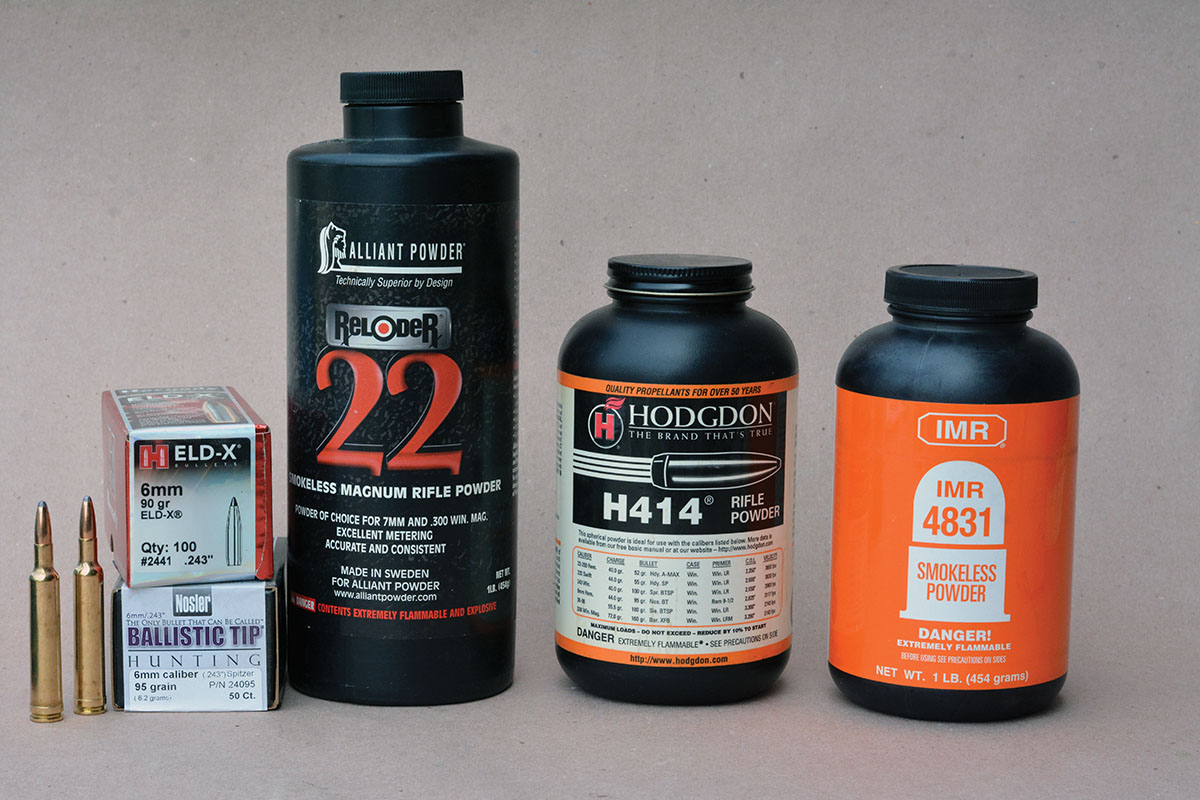
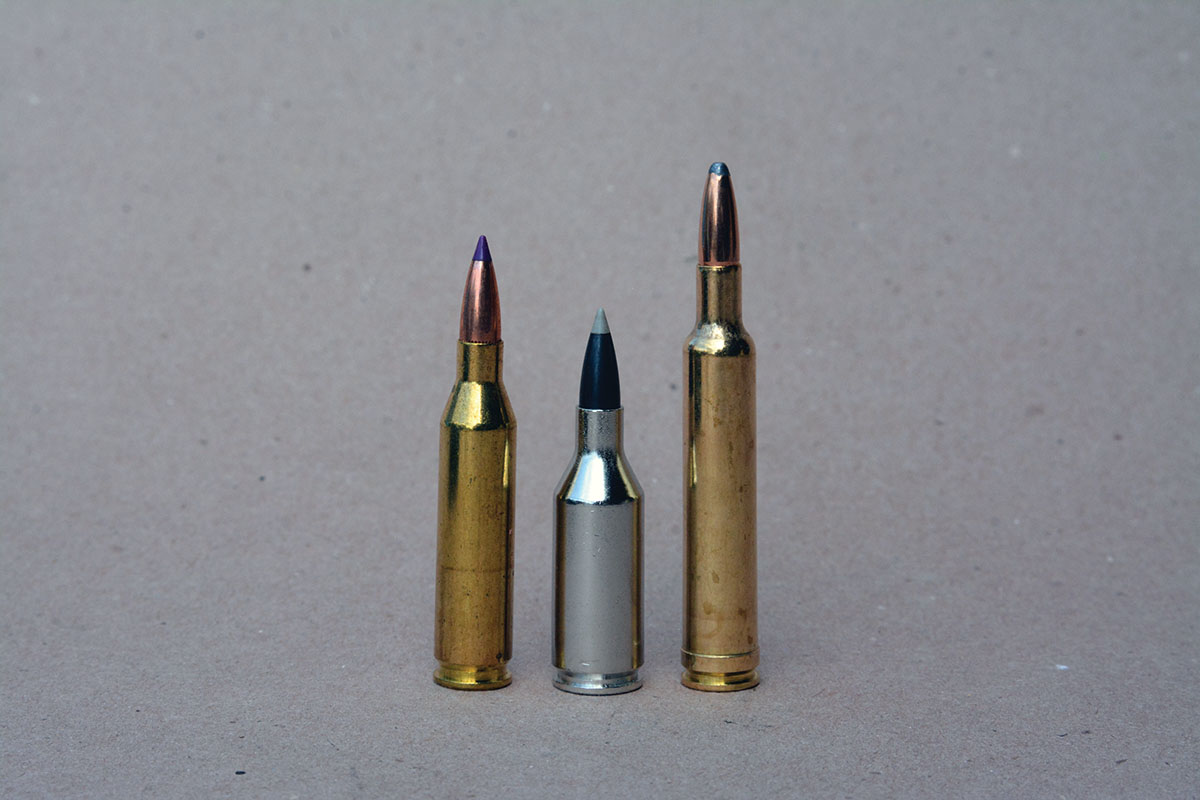
For reference, Weatherby lists the Barnes 80-grain TTSX bullet with a muzzle velocity of 3,500 fps. With a 300-yard zero, the bullet strikes 3.3 inches high at 200 yards and drops 21.6 inches at 500 yards. The Nosler 100-grain Partition bullet with a listed muzzle velocity of 3,406 fps produced a nearly identical trajectory. Regardless, the 240s flat trajectory can be beneficial in the field.
During my early years of shooting varmints and hunting big game on our large eastern Oregon and western Idaho cattle ranches, my Dad’s Remington Model 700 chambered in 243 Winchester was “borrowed” regularly and put to work. The cartridge worked great on coyotes and pests. However, when using conventional Winchester and Remington bullets on deer and antelope, its performance seemed less than spectacular. But that was more years ago than I care to admit and bullet technology has significantly changed the performance of 6mm cartridges on deer and antelope-sized game. In recent years, my sons and I have used the Barnes 80-grain TSX bullet, Hornady 80-grain GMX, 87-grain V-MAX, 90-grain ELD-X, 95-grain SST, the Nosler 90-grain AccuBond, 95-grain Ballistic Tip and 100-grain Partition on deer and antelope with excellent results. There are also many great hunting bullets from Swift, Cutting Edge and others that have hugely changed the field performance of 6mm-caliber cartridges.
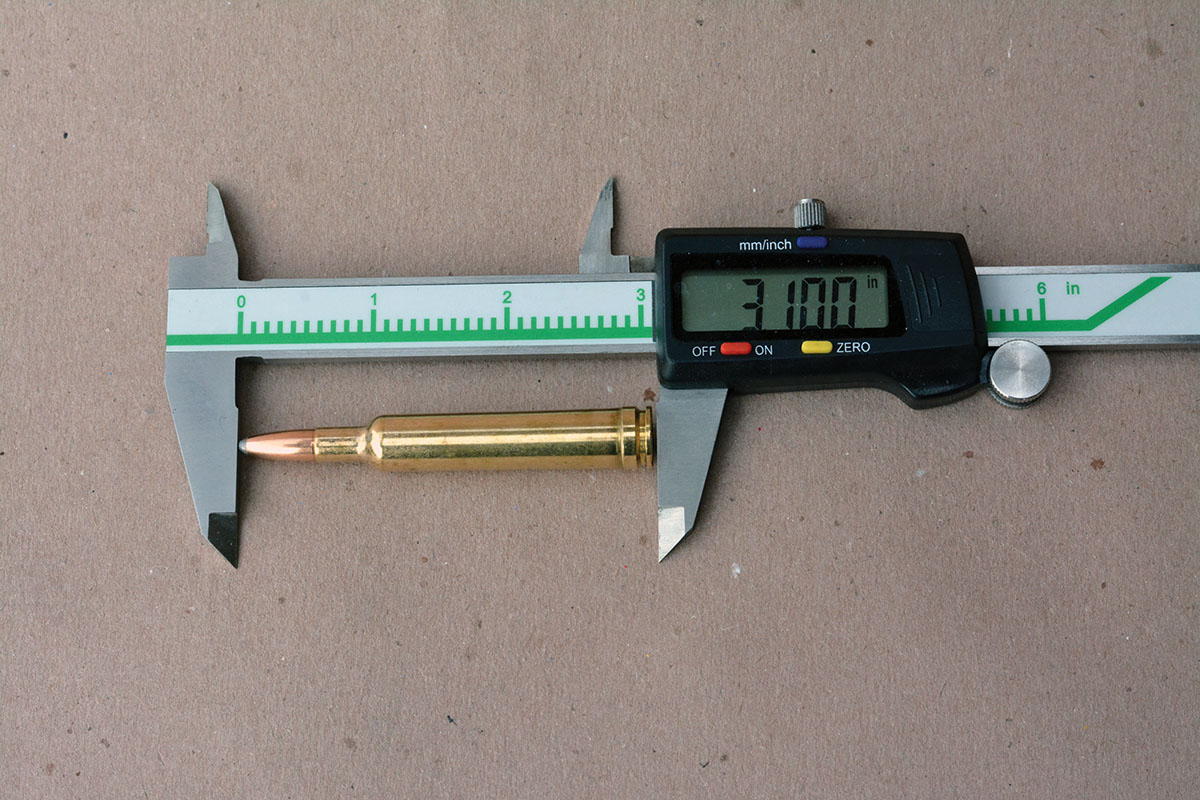
A Leupold VX-3 3.5-10x 40mm variable scope was installed on the Vanguard that features the Boone & Crockett reticle and a 1-inch tube that serves to keep weight down, but is also a rugged and reliable hunting scope.
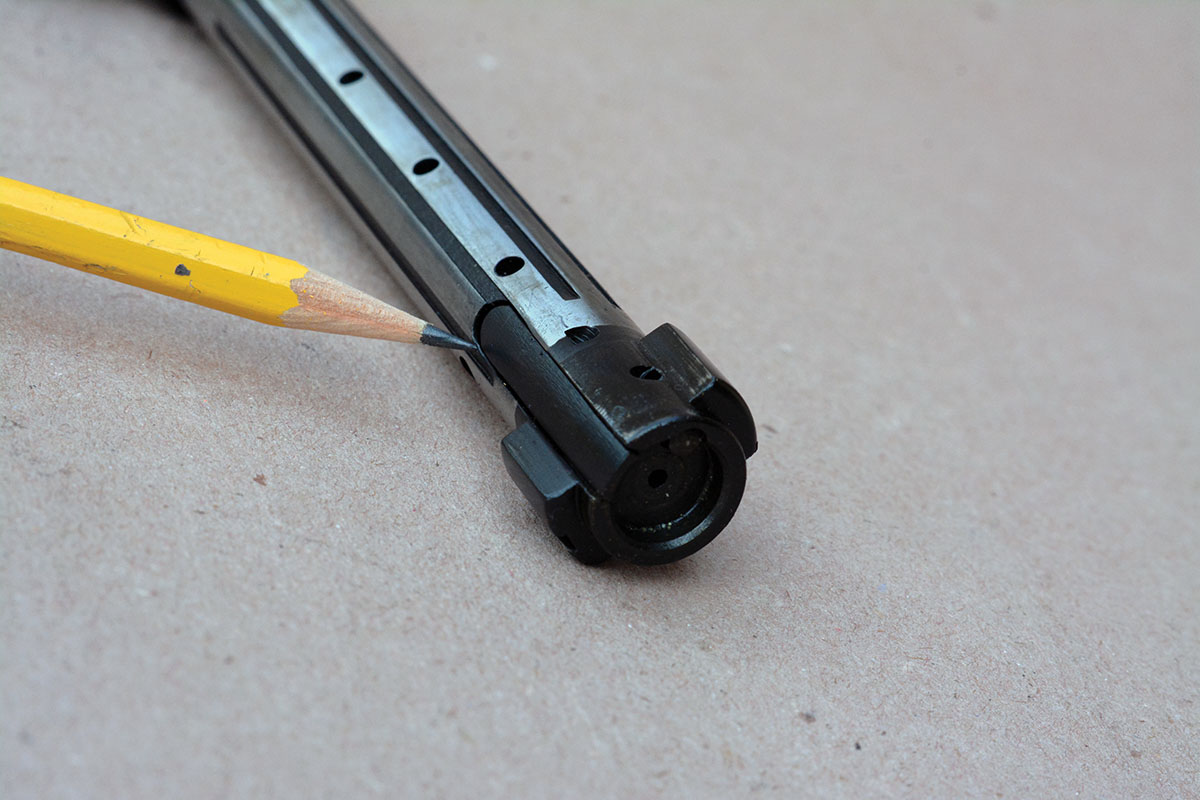
A few handloads were also tried, which included the Hornady 75-grain V-MAX bullet with 56 grains of H-414 for 3,703 fps. The Hornady 87-grain V-MAX was loaded ahead of 53 grains of IMR-4831 powder that reached 3,455 fps and the average group size was just .65 inch. The Nosler 90-grain AccuBond was loaded in conjunction with 52 grains of IMR-4831 for 3,411 fps and the average group size was less than ¾-inch. The Nosler 100-grain Partition was tried with 53 grains of Alliant Reloder 22 for 3,365 fps. After experimenting with bullet seating depth, each of the above loads easily grouped under MOA.
The Vanguard rifle has been a good rifle since its inception 54 years ago. However, it has progressed and become better along the way and Weatherby has been in touch with modern shooters by offering trending features and options. I have used them in the field with great satisfaction and fired many thousands of rounds with rifles chambered for at least 10 different cartridges while developing handloading data. It is an outstanding rifle that is well machined, reliable and accurate. Plus, with a competitive MSRP, it’s a bargain!



